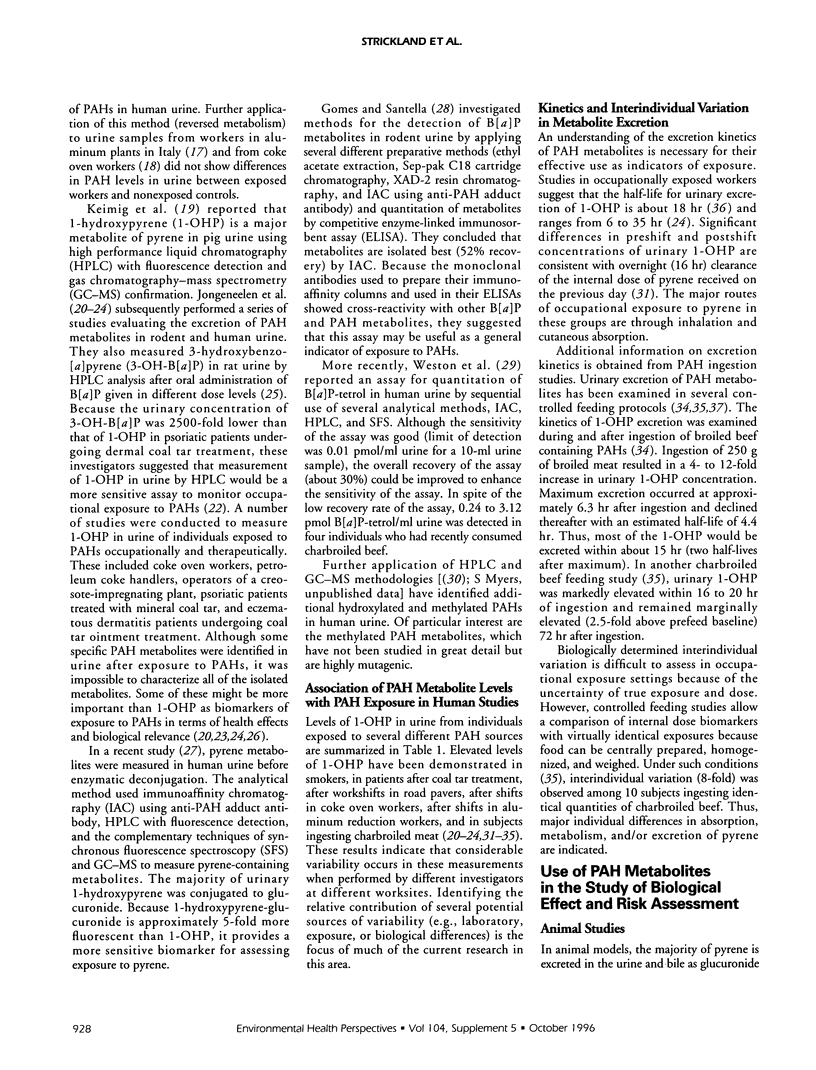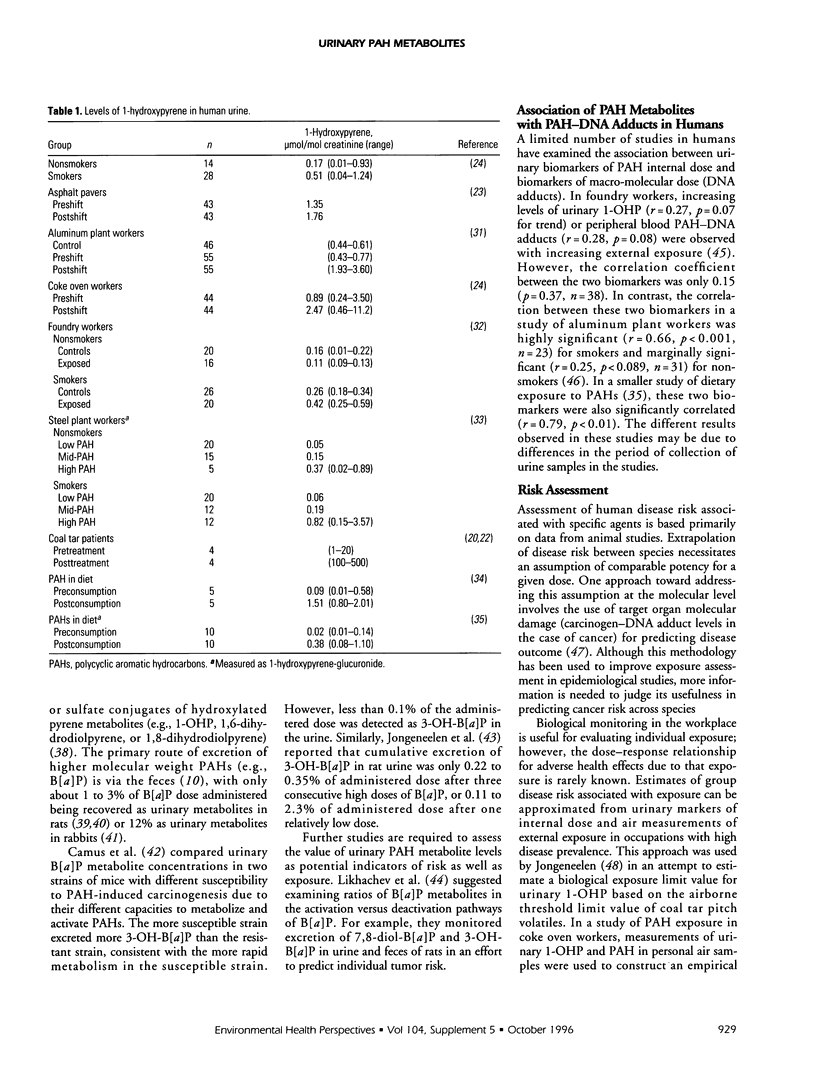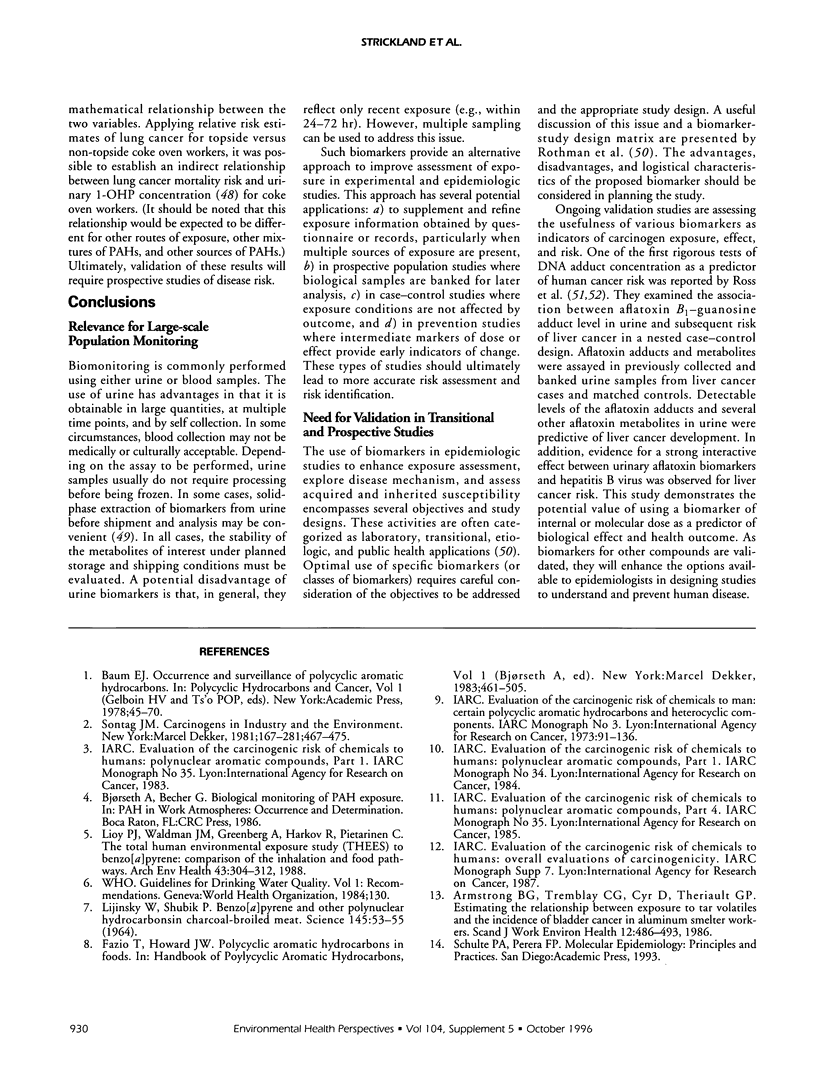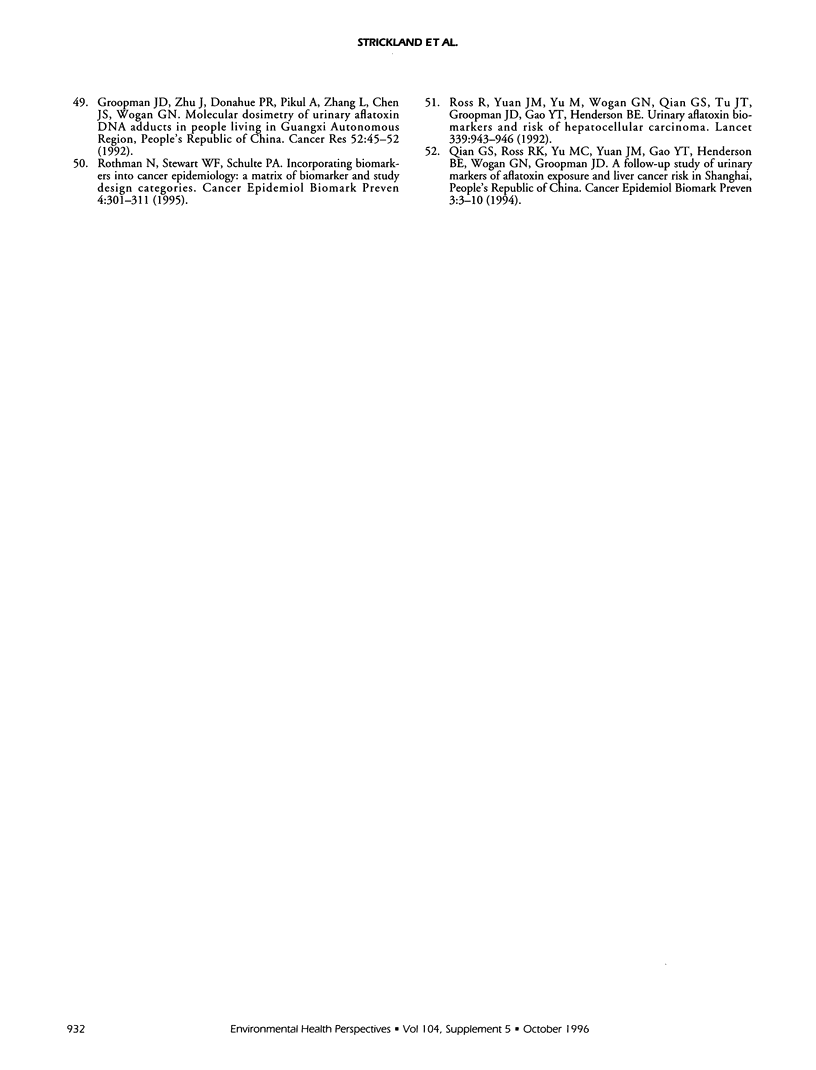Abstract
Humans are exposed to polycyclic aromatic hydrocarbons (PAHs) from various occupational, environmental, medicinal, and dietary sources. PAH metabolites in human urine can be used as biomarkers of internal dose to assess recent exposure to PAHs. PAH metabolites that have been detected in human urine include 1-hydroxypyrene (1-OHP), 1-hydroxypyrene-O-glucuronide (1-OHP-gluc), 3-hydroxybenzo[a]pyrene, 7,8,9,10-tetrahydroxy-7,8,9, 10-tetrahydrobenzo[a]pyrene, and a number of other hydroxylated PAHs. The most widely used of these is 1-OHP-gluc, the major form of 1-OHP in human urine, by virtue of its relatively high concentration and prevalence in urine and its ease of measurement. This metabolite of pyrene can be measured as 1-OHP after deconjugation of the glucuronide with beta-glucuronidase or directly as 1-OHP-gluc without deconjugation. Elevated levels of 1-OHP or 1-OHP-gluc have been demonstrated in smokers (versus nonsmokers), in patients receiving coal tar treatment (versus pretreatment), after workshifts in road pavers (versus before shifts or versus controls), after shifts in coke oven workers (versus before shift), and in subjects ingesting charbroiled meat (versus preingestion). More importantly, this metabolite is found (at low levels) in most human urine, even in persons without apparent occupational or smoking exposure. Although measurement of these metabolites is useful in assessing recent exposure to PAHs, their value as predictive markers of biological effect or health outcomes has not been rigorously tested and at present can only be inferred by association.
Full text
PDF





Selected References
These references are in PubMed. This may not be the complete list of references from this article.
- Armstrong B. G., Tremblay C. G., Cyr D., Thériault G. P. Estimating the relationship between exposure to tar volatiles and the incidence of bladder cancer in aluminum smelter workers. Scand J Work Environ Health. 1986 Oct;12(5):486–493. doi: 10.5271/sjweh.2109. [DOI] [PubMed] [Google Scholar]
- Becher G., Bjørseth A. Determination of exposure to polycyclic aromatic hydrocarbons by analysis of human urine. Cancer Lett. 1983 Jan;17(3):301–311. doi: 10.1016/0304-3835(83)90168-4. [DOI] [PubMed] [Google Scholar]
- Becher G., Haugen A., Bjørseth A. Multimethod determination of occupational exposure to polycyclic aromatic hydrocarbons in an aluminum plant. Carcinogenesis. 1984 May;5(5):647–651. doi: 10.1093/carcin/5.5.647. [DOI] [PubMed] [Google Scholar]
- Boyland E., Sims P. Metabolism of polycyclic compounds. 23. The metabolism of pyrene in rats and rabbits. Biochem J. 1964 Feb;90(2):391–398. doi: 10.1042/bj0900391. [DOI] [PMC free article] [PubMed] [Google Scholar]
- Buchet J. P., Gennart J. P., Mercado-Calderon F., Delavignette J. P., Cupers L., Lauwerys R. Evaluation of exposure to polycyclic aromatic hydrocarbons in a coke production and a graphite electrode manufacturing plant: assessment of urinary excretion of 1-hydroxypyrene as a biological indicator of exposure. Br J Ind Med. 1992 Nov;49(11):761–768. doi: 10.1136/oem.49.11.761. [DOI] [PMC free article] [PubMed] [Google Scholar]
- Buckley T. J., Lioy P. J. An examination of the time course from human dietary exposure to polycyclic aromatic hydrocarbons to urinary elimination of 1-hydroxypyrene. Br J Ind Med. 1992 Feb;49(2):113–124. doi: 10.1136/oem.49.2.113. [DOI] [PMC free article] [PubMed] [Google Scholar]
- Camus A. M., Aitio A., Sabadie N., Wahrendorf J., Bartsch H. Metabolism and urinary excretion of mutagenic metabolites of benzo[a]pyrene in C57 and DBA mice strains. Carcinogenesis. 1984 Jan;5(1):35–39. doi: 10.1093/carcin/5.1.35. [DOI] [PubMed] [Google Scholar]
- Chipman J. K., Bhave N. A., Hirom P. C., Millburn P. Metabolism and excretion of benzo[a]pyrene in the rabbit. Xenobiotica. 1982 Jun;12(6):397–404. doi: 10.3109/00498258209052481. [DOI] [PubMed] [Google Scholar]
- Chipman J. K., Hirom P. C., Frost G. S., Millburn P. The biliary excretion and enterohepatic circulation of benzo(a)pyrene and its metabolites in the rat. Biochem Pharmacol. 1981 May 1;30(9):937–944. doi: 10.1016/0006-2952(81)90037-x. [DOI] [PubMed] [Google Scholar]
- Clonfero E., Zordan M., Venier P., Paleologo M., Levis A. G., Cottica D., Pozzoli L., Jongeneelen F. J., Bos R. P., Anzion R. B. Biological monitoring of human exposure to coal tar. Urinary excretion of total polycyclic aromatic hydrocarbons, 1-hydroxypyrene and mutagens in psoriatic patients. Int Arch Occup Environ Health. 1989;61(6):363–368. doi: 10.1007/BF00381025. [DOI] [PubMed] [Google Scholar]
- Gaylor D. W., Kadlubar F. F., Beland F. A. Application of biomarkers to risk assessment. Environ Health Perspect. 1992 Nov;98:139–141. doi: 10.1289/ehp.9298139. [DOI] [PMC free article] [PubMed] [Google Scholar]
- Gomes M., Santella R. M. Immunologic methods for the detection of benzo[a]pyrene metabolites in urine. Chem Res Toxicol. 1990 Jul-Aug;3(4):307–310. doi: 10.1021/tx00016a006. [DOI] [PubMed] [Google Scholar]
- Groopman J. D., Zhu J. Q., Donahue P. R., Pikul A., Zhang L. S., Chen J. S., Wogan G. N. Molecular dosimetry of urinary aflatoxin-DNA adducts in people living in Guangxi Autonomous Region, People's Republic of China. Cancer Res. 1992 Jan 1;52(1):45–52. [PubMed] [Google Scholar]
- Haugen A., Becher G., Benestad C., Vahakangas K., Trivers G. E., Newman M. J., Harris C. C. Determination of polycyclic aromatic hydrocarbons in the urine, benzo(a)pyrene diol epoxide-DNA adducts in lymphocyte DNA, and antibodies to the adducts in sera from coke oven workers exposed to measured amounts of polycyclic aromatic hydrocarbons in the work atmosphere. Cancer Res. 1986 Aug;46(8):4178–4183. [PubMed] [Google Scholar]
- Jongeneelen F. J., Anzion R. B., Henderson P. T. Determination of hydroxylated metabolites of polycyclic aromatic hydrocarbons in urine. J Chromatogr. 1987 Jan 23;413:227–232. doi: 10.1016/0378-4347(87)80230-x. [DOI] [PubMed] [Google Scholar]
- Jongeneelen F. J., Anzion R. B., Leijdekkers C. M., Bos R. P., Henderson P. T. 1-hydroxypyrene in human urine after exposure to coal tar and a coal tar derived product. Int Arch Occup Environ Health. 1985;57(1):47–55. doi: 10.1007/BF00383545. [DOI] [PubMed] [Google Scholar]
- Jongeneelen F. J., Anzion R. B., Scheepers P. T., Bos R. P., Henderson P. T., Nijenhuis E. H., Veenstra S. J., Brouns R. M., Winkes A. 1-Hydroxypyrene in urine as a biological indicator of exposure to polycyclic aromatic hydrocarbons in several work environments. Ann Occup Hyg. 1988;32(1):35–43. doi: 10.1093/annhyg/32.1.35. [DOI] [PubMed] [Google Scholar]
- Jongeneelen F. J. Biological exposure limit for occupational exposure to coal tar pitch volatiles at cokeovens. Int Arch Occup Environ Health. 1992;63(8):511–516. doi: 10.1007/BF00386338. [DOI] [PubMed] [Google Scholar]
- Jongeneelen F. J., Bos R. P., Anzion R. B., Theuws J. L., Henderson P. T. Biological monitoring of polycyclic aromatic hydrocarbons. Metabolites in urine. Scand J Work Environ Health. 1986 Apr;12(2):137–143. doi: 10.5271/sjweh.2166. [DOI] [PubMed] [Google Scholar]
- Jongeneelen F. J., Leijdekkers C. M., Bos R. P., Theuws J. L., Henderson P. T. Excretion of 3-hydroxy-benzo(a)pyrene and mutagenicity in rat urine after exposure to benzo(a)pyrene. J Appl Toxicol. 1985 Oct;5(5):277–282. doi: 10.1002/jat.2550050503. [DOI] [PubMed] [Google Scholar]
- Jongeneelen F. J., Leijdekkers C. M., Henderson P. T. Urinary excretion of 3-hydroxy-benzo[a]pyrene after percutaneous penetration and oral absorption of benzo[a]pyrene in rats. Cancer Lett. 1984 Dec;25(2):195–201. doi: 10.1016/s0304-3835(84)80045-2. [DOI] [PubMed] [Google Scholar]
- Jongeneelen F. J., van Leeuwen F. E., Oosterink S., Anzion R. B., van der Loop F., Bos R. P., van Veen H. G. Ambient and biological monitoring of cokeoven workers: determinants of the internal dose of polycyclic aromatic hydrocarbons. Br J Ind Med. 1990 Jul;47(7):454–461. doi: 10.1136/oem.47.7.454. [DOI] [PMC free article] [PubMed] [Google Scholar]
- Kang D. H., Rothman N., Poirier M. C., Greenberg A., Hsu C. H., Schwartz B. S., Baser M. E., Groopman J. D., Weston A., Strickland P. T. Interindividual differences in the concentration of 1-hydroxypyrene-glucuronide in urine and polycyclic aromatic hydrocarbon-DNA adducts in peripheral white blood cells after charbroiled beef consumption. Carcinogenesis. 1995 May;16(5):1079–1085. doi: 10.1093/carcin/16.5.1079. [DOI] [PubMed] [Google Scholar]
- Kang D., Rothman N., Cho S. H., Lim H. S., Kwon H. J., Kim S. M., Schwartz B., Strickland P. T. Association of exposure to polycyclic aromatic hydrocarbons (estimated from job category) with concentration of 1-hydroxypyrene glucuronide in urine from workers at a steel plant. Occup Environ Med. 1995 Sep;52(9):593–599. doi: 10.1136/oem.52.9.593. [DOI] [PMC free article] [PubMed] [Google Scholar]
- Keimig S. D., Kirby K. W., Morgan D. P., Keiser J. E., Hubert T. D. Identification of 1-hydroxypyrene as a major metabolite of pyrene in pig urine. Xenobiotica. 1983 Jul;13(7):415–420. doi: 10.3109/00498258309052279. [DOI] [PubMed] [Google Scholar]
- LIJINSKY W., SHUBIK P. BENZO(A)PYRENE AND OTHER POLYNUCLEAR HYDROCARBONS IN CHARCOAL-BROILED MEAT. Science. 1964 Jul 3;145(3627):53–55. doi: 10.1126/science.145.3627.53. [DOI] [PubMed] [Google Scholar]
- Likhachev A. J., Beniashvili D. Sh, Bykov V. J., Dikun P. P., Tyndyk M. L., Savochkina I. V., Yermilov V. B., Zabezhinski M. A. Biomarkers for individual susceptibility to carcinogenic agents: excretion and carcinogenic risk of benzo[a]pyrene metabolites. Environ Health Perspect. 1992 Nov;98:211–214. doi: 10.1289/ehp.9298211. [DOI] [PMC free article] [PubMed] [Google Scholar]
- Lioy P. L., Waldman J. M., Greenberg A., Harkov R., Pietarinen C. The Total Human Environmental Exposure Study (THEES) to benzo(a)pyrene: comparison of the inhalation and food pathways. Arch Environ Health. 1988 Jul-Aug;43(4):304–312. doi: 10.1080/00039896.1988.10545954. [DOI] [PubMed] [Google Scholar]
- Qian G. S., Ross R. K., Yu M. C., Yuan J. M., Gao Y. T., Henderson B. E., Wogan G. N., Groopman J. D. A follow-up study of urinary markers of aflatoxin exposure and liver cancer risk in Shanghai, People's Republic of China. Cancer Epidemiol Biomarkers Prev. 1994 Jan-Feb;3(1):3–10. [PubMed] [Google Scholar]
- Ross R. K., Yuan J. M., Yu M. C., Wogan G. N., Qian G. S., Tu J. T., Groopman J. D., Gao Y. T., Henderson B. E. Urinary aflatoxin biomarkers and risk of hepatocellular carcinoma. Lancet. 1992 Apr 18;339(8799):943–946. doi: 10.1016/0140-6736(92)91528-g. [DOI] [PubMed] [Google Scholar]
- Rothman N., Stewart W. F., Schulte P. A. Incorporating biomarkers into cancer epidemiology: a matrix of biomarker and study design categories. Cancer Epidemiol Biomarkers Prev. 1995 Jun;4(4):301–311. [PubMed] [Google Scholar]
- Santella R. M., Hemminki K., Tang D. L., Paik M., Ottman R., Young T. L., Savela K., Vodickova L., Dickey C., Whyatt R. Polycyclic aromatic hydrocarbon-DNA adducts in white blood cells and urinary 1-hydroxypyrene in foundry workers. Cancer Epidemiol Biomarkers Prev. 1993 Jan-Feb;2(1):59–62. [PubMed] [Google Scholar]
- Sherson D., Sigsgaard T., Overgaard E., Loft S., Poulsen H. E., Jongeneelen F. J. Interaction of smoking, uptake of polycyclic aromatic hydrocarbons, and cytochrome P450IA2 activity among foundry workers. Br J Ind Med. 1992 Mar;49(3):197–202. doi: 10.1136/oem.49.3.197. [DOI] [PMC free article] [PubMed] [Google Scholar]
- Strickland P. T., Kang D., Bowman E. D., Fitzwilliam A., Downing T. E., Rothman N., Groopman J. D., Weston A. Identification of 1-hydroxypyrene glucuronide as a major pyrene metabolite in human urine by synchronous fluorescence spectroscopy and gas chromatography-mass spectrometry. Carcinogenesis. 1994 Mar;15(3):483–487. doi: 10.1093/carcin/15.3.483. [DOI] [PubMed] [Google Scholar]
- Venier P., Clonfero E., Cottica D., Gava C., Zordan M., Pozzoli L., Levis A. G. Mutagenic activity and polycyclic aromatic hydrocarbon levels in urine of workers exposed to coal tar pitch volatiles in an anode plant. Carcinogenesis. 1985 May;6(5):749–752. doi: 10.1093/carcin/6.5.749. [DOI] [PubMed] [Google Scholar]
- Weston A., Bowman E. D., Carr P., Rothman N., Strickland P. T. Detection of metabolites of polycyclic aromatic hydrocarbons in human urine. Carcinogenesis. 1993 May;14(5):1053–1055. doi: 10.1093/carcin/14.5.1053. [DOI] [PubMed] [Google Scholar]
- van Maanen J. M., Moonen E. J., Maas L. M., Kleinjans J. C., van Schooten F. J. Formation of aromatic DNA adducts in white blood cells in relation to urinary excretion of 1-hydroxypyrene during consumption of grilled meat. Carcinogenesis. 1994 Oct;15(10):2263–2268. doi: 10.1093/carcin/15.10.2263. [DOI] [PubMed] [Google Scholar]
- van Schooten F. J., Jongeneelen F. J., Hillebrand M. J., van Leeuwen F. E., de Looff A. J., Dijkmans A. P., van Rooij J. G., den Engelse L., Kriek E. Polycyclic aromatic hydrocarbon-DNA adducts in white blood cell DNA and 1-hydroxypyrene in the urine from aluminum workers: relation with job category and synergistic effect of smoking. Cancer Epidemiol Biomarkers Prev. 1995 Jan-Feb;4(1):69–77. [PubMed] [Google Scholar]


